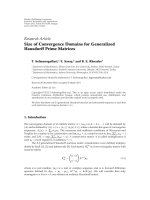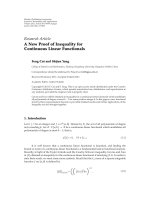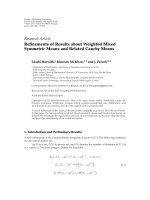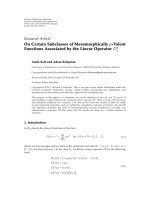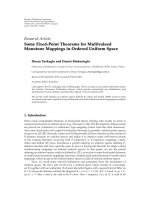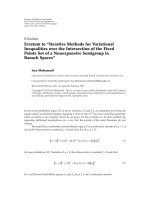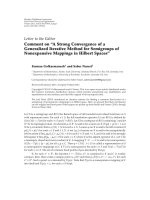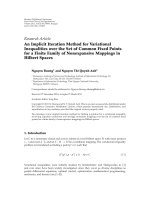Hindawi Publishing Corporation Advances in Difference Equations Volume 2011, Article ID 584874, 13 pdf
Bạn đang xem bản rút gọn của tài liệu. Xem và tải ngay bản đầy đủ của tài liệu tại đây (527.22 KB, 13 trang )
Hindawi Publishing Corporation
Advances in Difference Equations
Volume 2011, Article ID 584874, 13 pages
doi:10.1155/2011/584874
Research Article
Weighted S-Asymptotically ω-Periodic Solutions of
a Class of Fractional Differential Equations
Claudio Cuevas,
1
Michelle Pierri,
2
and Alex Sepulveda
3
1
Departamento de Matem
´
atica, Universidade Federal de Pernambuco, 50540-740 Recife, PE, Brazil
2
Departamento de F
´
ısica e Matem
´
atica da Faculdade de Filosofia, Ci
ˆ
encias e Letras de Ribeir
˜
ao Preto,
Universidade de S
˜
ao Paulo, 14040-901 Ribeir
˜
ao Preto, SP, Brazil
3
Departamento de Matem
´
atica y Estad
´
ıstica, Universidad de La Frontera, Casilla 54-D, Temuco, Chile
Correspondence should be addressed to Claudio Cuevas,
Received 23 September 2010; Accepted 8 December 2010
Academic Editor: J. J. Trujillo
Copyright q 2011 Claudio C uevas et al. This is an open access article distributed under the
Creative Commons Attribution License, which permits unrestricted use, distribution, and
reproduction in any medium, provided the original work i s properly cited.
We study the existence of weighted S-asymptotically ω-periodic mild solutions for a class of
abstract fractional differential equations of the form u
∂
−α1
Au ft, u, 1 <α<2, where A
is a linear sectorial operator of negative type.
1. Introduction
S-asymptotically ω-periodic functions have applications to several problems, for example
in the theory of functional differential equations, fractional differential equations, integral
equations and partial differential equations. The concept of S-asymptotic ω-periodicity was
introduced in the literature by Henr
´
ıquez et al. 1, 2. Since then, it attracted the attention
of many researchers see 1–10. In Pierri 10 a new S-asymptotically ω-periodic space
was introduced. It is called the space of weighted S-asymptotically ω-periodic or Sv-
asymptotically ω-periodic functions. In particular, the author has established conditions
under which a Sv-asymptotically ω-periodic function is asymptotically ω-periodic and also
discusses the existence of Sv-asymptotically ω-periodic solutions for an integral abstract
Cauchy problem. The author has applied the results to partial integrodifferential equations.
We study in this paper sufficient conditions for the existence and uniqueness
of a weighted S-asymptotically ω-periodic mild solution to the following semi-linear
integrodifferential equation of fractional order
v
t
t
0
t − s
α−2
Γ
α − 1
Av
s
ds f
t, v
t
,t≥ 0,
1.1
2 Advances in Difference Equations
v
0
u
0
∈ X, 1.2
where 1 <α<2, A : DA ⊆ X → X is a linear densely defined operator of sectorial type on
a complex Banach space X and f : 0, ∞ × X → X is an appropriate function. Note that the
convolution integral in 1.1 is known as the Riemann-Liouville fractional integral 11.We
remark that there is much interest in developing theoretical analysis and numerical methods
for fractional integrodifferential equations because they have recently proved to be valuable
in various fields of sciences and engineering. For details, including some applications and
recent results, see the monographs of Ahn and MacVinish 12, Gorenflo and Mainardi 13
and Trujillo et al. 14–16 and the papers of Agarwal et al. 17–23,Cuesta11, 24, Cuevas
et al. 5, 6, dos Santos and Cuevas 25, Eidelman and Kochubei 26, Lakshmikantham et
al. 27–30, Mophou and N’Gu
´
er
´
ekata
31, Ahmed and Nieto 32,andN’Gu
´
er
´
ekata 33.In
particular equations of type 1.1 are attracting increasing interest cf. 5, 11, 24, 34.
The existence of weighted S-asymptotically ω-periodic mild solutions for integrodif-
ferential equation of fractional order of type 1.1 remains an untreated topic in the literature.
Anticipating a wide interest in the subject, this paper contributes in filling this important gap.
In particular, to illustrate our main results, we examine sufficient conditions for the existence
and uniqueness of a weighted S-asymptotically ω-periodic mild solution to a fractional
oscillation equation.
2. Preliminaries and Basic Results
In this section, we introduce notations, definitions and preliminary facts which are used
throughout this paper. Let Z, ·
Z
and Y, ·
Y
be Banach spaces. The notation BZ, Y
stands for the space of bounded linear operators from Z into Y endowed with the uniform
operator topology denoted ·
BZ,Y
, and we abbreviate to BZ and ·
BZ
whenever
Z Y . In this paper C
b
0, ∞,Z denotes the Banach space consisting of all continuous
and bounded functions from 0, ∞ into Z with the norm of the uniform convergence. For a
closed linear operator B we denote by ρB the resolvent set and by σB the spectrum of B
that is, the complement of ρB in the complex plane.SetλI − B
−1
the resolvent of B for
λ ∈ ρB.
2.1. Sectorial Linear Operators and the Solution Operator for
Fractional Equations
A closed and linear operator A is said sectorial of type μ if there are 0 <θ<π/2,M>0
and μ ∈ R such that the spectrum of A is contained in the sector μ Σ
θ
: {μ λ : λ ∈
C, |arg−λ| <θ} and λ − A
−1
≤M/|λ − μ|, for all λ
/
∈μ Σ
θ
.
In order to give an operator theoretical approach for the study of t he abstract system
we recall the following definition.
Definition 2.1 see 17.LetA be a closed linear operator with domain DA in a Banach
space X. One calls A the generator of a solution operator for 1.1-1.2 if there are μ ∈ R
and a strongly continuous function S
α
: R
→BX such that {λ
α
:Reλ>μ}⊆ρA and
λ
α−1
λ
α
− A
−1
x
∞
0
e
−λt
S
α
txdt, for all Re λ>μ,x∈ X. In this case, S
α
t is called the
solution operator generated by A.By35, Proposition 2.6, S
α
0I. We observe that the
power function λ
α
is uniquely defined as λ
α
|λ|
α
e
i arg λ
,with−π<argλ <π.
Advances in Difference Equations 3
We note that if A is a sectorial of type μ with 0 ≤ θ ≤ π1 − α/2, then A is the
generator of a solution operator given by S
α
t :1/2πi
γ
e
λt
λ
α−1
λ
α
−A
−1
dλ, t>0, where
γ is a suitable path lying outside the sector μ Σ
θ
cf. 11. Recently, Cuesta 11, Theorem 1
proved that if A is a sectorial operator of type μ<0 for some M>0and0≤ θ ≤ π1 − α/2,
then there exists C>0 such that
S
α
t
BX
≤
CM
1
μ
t
α
,t≥ 0.
2.1
Remark 2.2. In the remainder of this paper, we always assume that A is a a sectorial of type
μ<0andM, C, are the constants introduced above.
2.2. Weighted S-Asymptotically ω-Periodic Functions
We recall the following definitions.
Definition 2.3 see 1.Afunctionf ∈ C
b
0, ∞,Z is called S-asymptotically ω-periodic if
there exists ω>0 such that lim
t →∞
ft ω − ft 0. In this case, we say that ω is an
asymptotic period of f·.
Throughout this paper, SAP
ω
Z represents the space formed for all the Z-valued S-
asymptotically ω-periodic functions endowed with the uniform convergence norm denoted
·
∞
. It is clear that SAP
ω
Z is a Banach space see 1, P roposition 3.5.
Definition 2.4 see 10.Letv ∈ C
b
0, ∞, 0, ∞.Afunctionf ∈ C
b
0, ∞,Z is called
weighted S-asymptotically ω-periodic or Sv-asymptotically ω-periodic if lim
t →∞
ftω−
ft/vt0.
In this paper, SAP
ω
Z, v represents the space formed by all the Sv-asymptotically
ω-periodic functions endowed with the norm
f
SAP
ω
Z,v
f
∞
f
v
sup
t≥0
ft
Z
sup
t≥0
ft ω − ft
Z
v
t
.
2.2
Proposition 2.5. The space SAP
v
ω
X is a Banach space.
Proof. Let f
n
n∈N
be a Cauchy sequence in SAP
v
ω
X. From the definition of ·
S
v
ω
Z
, there
exists f ∈ C
b
0, ∞,X such that f
n
→ f in C
b
0, ∞,X. Next, we prove that f
n
→ f in
SAP
v
ω
X.
By noting that f
n
n
is a Cauchy sequence, for ε>0 given there exists N
ε
∈ N such that
f
n
− f
m
S
v
ω
Z
<ε, for all n, m ≥ N
ε
, which implies
f
n
− f
m
t
<ε, ∀t ≥ 0, ∀n, m ≥ N
ε
,
f
n
− f
m
t ω
−
f
n
− f
m
t
v
t
<ε, ∀t ≥ 0, ∀n, m ≥ N
ε
.
2.3
4 Advances in Difference Equations
Under the above conditions, for t ≥ 0andn ≥ N
ε
we see that
f
n
t
− f
t
f
n
− f
t ω
−
f
n
− f
t
v
t
lim
m →∞
f
n
t
− f
m
t
f
n
− f
m
t ω
−
f
n
− f
m
t
v
t
≤ 2,
2.4
which implies that f
n
− f
S
v
ω
Z
≤ 2 for n ≥ N
ε
and f
n
− f
S
v
ω
Z
→ 0asn →∞.
To conclude the proof we need to show that f ∈ SAP
v
ω
X.LetN
ε
as above. Since
f
N
ε
∈ SAP
v
ω
X, there exits L
ε
> 0 such that f
N
ε
t ω − f
N
ε
t/vt <εfor all t ≥ L
ε
.Now,
by using that f
N
ε
− f
S
v
ω
Z
≤ 2,fort ≥ L
we get
f
t ω
− f
t
v
t
≤
f
t ω
− f
N
ε
t ω
−
f
t
− f
N
ε
t
v
t
f
N
ε
t ω
− f
N
ε
t
v
t
< 2ε ε,
2.5
which implies that lim
t →∞
ft ω − ft/vt 0. This completes the proof.
Definition 2.6. A function f ∈ C0, ∞ × Z, Y is called uniformly Sv-asymptotically ω-
periodic on bounded sets if for every bounded subset K ⊆ Z,theset{ft, x : t ≥ 0,x ∈ K}
is bounded and lim
t →∞
ft ω, x − ft, x
Y
/vt0, uniformly for x ∈ K.Ifv ≡ 1wesay
that f· is uniformly S-asymptotically ω-periodic on bounded sets see 1.
To prove some of our results, we need the f ollowing lemma.
Lemma 2.7. Let v ∈ C
b
0, ∞, 0, ∞. Assume f ∈ C0, ∞ × Z, Y is uniformly Sv-
asymptotically ω-periodic on bounded sets and there is L>0 such that
ft, x − ft, y
Y
≤ L
x − y
Z
, ∀t ≥ 0, ∀x, y ∈ Z. 2.6
If u ∈ SAP
ω
Z, v, then the function t → ft, ut belongs to SAP
ω
Y, v.
Advances in Difference Equations 5
Proof. Using the fact that Ru{ut : t ≥ 0} is bounded, it follows that f·,u· ∈
C
b
0, ∞,Y. For >0 be given, we select T
> 0 such that
ft ω, z − ft, z
Y
v
t
≤
2
,
ut ω − ut
Z
v
t
≤
2L
,
2.7
for all t ≥ T
and z ∈Ru. Then, for t ≥ T
we see that
ft ω, ut ω − ft, ut
Y
v
t
≤
ft ω, ut ω − f
t, u
t ω
Y
v
t
ft, ut ω − f
t, u
t
Y
v
t
≤
2
L
ut ω − u
t
Z
v
t
≤
2
2
,
2.8
which proves t he assertion.
Lemma 2.8. Let v ∈ C
b
0, ∞, 0, ∞.Letu ∈ SAP
ω
X, v and l
α
: 0, ∞ → X be the f unction
defined by
l
α
t
t
0
S
α
t − s
u
s
ds. 2.9
If vtt
α−1
→∞as t →∞and Θ : sup
t≥0
1/vt
t
0
vt − s/1 |μ|s
α
ds < ∞,then
l
α
∈ SAP
ω
X, v.
Proof. From the estimate l
α
∞
≤ CM|μ|
−1/α
π/αsinπ/α, it follows that l
α
∈ C
b
0, ∞,X.
For ε>0 be given we select T
> 0 such that
u
t ω
− u
t
v
t
≤ ε,
CM
1 2
α
u
∞
α − 1
μ
v
t
t
α−1
≤ ε,
2.10
6 Advances in Difference Equations
for all t ≥ T
. Under these conditions, for t ≥ 2T
we have that
l
α
t ω
− l
α
t
v
t
≤
1
v
t
ω
0
S
α
t ω − s
BX
us
X
ds
1
v
t
T
0
S
α
t − s
BX
us ω − us
X
ds
1
v
t
t
T
S
α
t − s
BX
us ω − us
X
ds
≤
CM
u
∞
v
t
tω
t
1
1
μ
s
α
ds 2
t
t−T
1
1
μ
s
α
ds
CM
v
t
t−T
0
v
t − s
1
μ
s
α
ds
≤
CM
1 2
α
u
∞
α − 1
μ
1
v
t
t
α−1
CMεΘ
≤ ε
1 CMΘ
,
2.11
which completes the proof.
3. Existence of Weighted S-Asymptotically ω-Periodic Solutions
In this section we discuss the existence of weighted S-asymptotically ω-periodic solutions
for the abstract system 1.1-1.2. To begin, we recall the definition of mild solution for 1.1-
1.2.
Definition 3.1 see 5.Afunctionu ∈ C
b
0, ∞,X is called a mild solution of the abstract
Cauchy problem 1.1-1.2 if
u
t
S
α
t
u
0
t
0
S
α
t − s
f
s, u
s
ds, ∀t ∈ R
. 3.1
Now, we can establish our first existence result.
Theorem 3.2. Assume f : 0, ∞ × X → X is a uniformly S-asymptotically ω-periodic on bounded
sets function and there is a mesurable bounded function L
f
: 0, ∞ → R
such that
f
t, x
− f
t, y
≤ L
f
t
x − y
, ∀t ∈ R, ∀x, y ∈ X. 3.2
If Λ : CMsup
t≥0
t
0
L
f
s/1 |μ|t − s
α
ds < 1, then there exits a unique S-asymptotically
ω-periodic mild solution u· of 1.1-1.2. Suppose, there is a function L
u
: 0, ∞ → R
such that
1 |μ|·
α
L
u
· ∈ L
1
0, ∞ and ft ω, x − ft, x≤L
u
t, for every x ∈Ru{us :
s ≥ 0} and all t ≥ 0.Ifv ∈ C
b
0, ∞, 0, ∞ is such that 1/vt1 |μ|t
α
e
2
α
CM
t
0
L
f
sds
→ 0
as t →∞,thenu· is weighted S-asymptotically ω-periodic.
Advances in Difference Equations 7
Proof. Let F
α
:SAP
ω
X → C
b
0, ∞,X be the operator defined by
F
α
u
t
S
α
t
u
0
t
0
S
α
t − s
f
s, u
s
ds : S
α
t
u
0
F
1
α
u
t
. 3.3
We show initially that F
α
is SAP
ω
X-valued. Since S
α
tu
0
→ 0, as t →∞,itis
sufficient to show that the function F
1
α
is SAP
ω
X-valued. Let u ∈ SAP
ω
X. Using the fact
that f·,u· is a bounded function, it follows that F
1
α
u ∈ C
b
0, ∞,X. For ε>0 be given,
we select a constant T
> 0 such that
sup
t≥T
,s≥0
f
t ω, u
s
− f
t, u
s
u
t ω
− u
t
<
ε
2
,
2CM
f
·,u
·
∞
∞
T
1
1
μ
s
α
ds <
ε
2
.
3.4
Then, for t ≥ 2L
we see that
F
1
α
u
t ω
− F
1
α
u
t
≤
ω
0
S
α
t ω − s
f
s, u
s
ds
T
0
S
α
t − s
f
s ω, u
s ω
− f
s, u
s ω
ds
T
0
S
α
t − s
f
s, u
s ω
− f
s, u
s
ds
t
T
S
α
t − s
f
s ω, u
s ω
− f
s, u
s ω
ds
t
T
S
α
t − s
f
s, u
s ω
− f
s, u
s
ds
≤ CM
f
·,u
·
∞
∞
t
1
1
μ
s
α
ds
∞
t/2
1
1
μ
s
α
ds
ε
2
CMsup
τ≥0
τ
0
L
f
τ −s
1
μ
s
α
ds
<
ε
2
ε
2
ε,
3.5
which implies that F
1
α
ut ω − F
1
α
ut → 0ast →∞, F
1
α
u ∈ SAP
ω
X and hence
F
α
SAP
ω
X ⊂ SAP
ω
X. Moreover, from the above estimate it is easy to infer that
F
α
u − F
α
v≤Λu − v, for all u, v ∈ SAP
ω
X, F
α
is a contraction and there exists a unique
S-asymptotically ω-periodic mild solution u· of 1.1-1.2.
8 Advances in Difference Equations
Next, we prove that last assertion. Let ξ : 0, ∞ → R
be the function defined by
ξtut ω − ut/vt. For t ≥ 0, we get
ξ
t
≤
S
α
t ω
u
0
− S
α
t
u
0
v
t
F
1
α
u
t ω
− F
1
α
u
t
v
t
≤
2CM
u
0
v
t
1
μ
t
α
1
v
t
ω
0
S
α
t ω − s
BX
f
s, u
s
ds
1
v
t
t
0
S
α
t − s
BX
f
s ω, u
s ω
− f
s, u
s
ds
2CM
u
0
v
t
1
μ
t
α
I
1
I
2
.
3.6
Concerning the quantities I
1
and I
2
,wenotethat
I
1
≤
CM
f
·,u
·
∞
v
t
tω
t
1
1
μ
s
α
ds
≤
CMω
f
·,u
·
∞
v
t
1
μ
t
α
,
I
2
≤
1
v
t
t
0
S
α
t − s
BX
f
s ω, u
s ω
− f
s, u
s ω
ds
1
v
t
t
0
S
α
t − s
BX
f
s, u
s ω
− f
s, u
s
ds
≤
CM
v
t
t
0
L
u
s
1
μ
t − s
α
ds
CM
v
t
t
0
L
f
s
v
s
ξ
s
1
μ
t − s
α
ds.
3.7
Using the estimates 3.7 in 3.6,weseethat
v
t
1
μ
t
α
ξ
t
≤ CM
2
u
0
f
·,u
·
∞
CM
t
0
1
μ
t
α
1
μ
t − s
α
L
u
s
ds
CM
t
0
1
μ
t
α
1
μ
t − s
α
L
s
v
s
ξ
s
ds
≤ CM
u
0
f
·,u
·
∞
2
α
t
0
1
μ
s
α
L
u
s
ds
2
α−1
CM
t
0
L
f
s
v
s
1
μ
s
α
ξ
s
ds
≤ P 2
α−1
CM
t
0
L
f
s
v
s
1
μ
s
α
ξ
s
ds,
3.8
Advances in Difference Equations 9
where P is a positive constant independent of t. Finally, by using the Gronwall-Bellman
inequality we infer that
lim
t →∞
u
t ω
− u
t
v
t
0,
3.9
which shows that u ∈ SAP
ω
X, v. This completes the proof.
Example 3.3. We set X L
2
0,π, A −ρ
α
I with 0 <ρ<1. Let g : R → R be a function
such that |gx − gy|≤L
g
x − y, for all x, y ∈ R and let f : 0, ∞ × X → X be defined by
ft, xξe
−t
α
gxξ, ξ ∈ 0,π. We observe that
ft ω, x − f
t, x
L
2
≤
√
2
e
−tω
α
− e
−t
α
L
g
x
L
2
g
0
√
π
,
3.10
whence f is S-asymptotically ω-periodic on bounded sets. By Theorem 3.2 we conclude that
if L
g
<αsinπ/α/πρ
−1
, then there is a unique S-asymptotically ω-periodic mild solution
u· of 1.1-1.2. Moreover u ∈ SAP
ω
X, 1/1 ρ
α
t.
Theorem 3.4. Let v ∈ C
b
0, ∞, 0, ∞. Assume G ∈ SAP
ω
BX,v, 1/vtt
α−1
→ 0 as t →
∞ and
Λ : CM
G
SAP
ω
BX,v
μ
−1/α
π
α sin
π/α
ω sup
t≥0
1
v
t
1
μ
t
α
2Θ
< 1,
3.11
where Θ is the constant introduced in Lemma 2.8.Then there is a unique weighted S-asymptotically
ω-periodic mild solution of
u
t
t
0
t − s
α−2
Γ
α − 1
Au
s
ds G
t
u
t
,t≥ 0,
u
0
u
0
∈ X.
3.12
Proof. The proof is based in Lemmas 2.7 and 2.8.LetΓ :SAP
ω
X, v → C
b
0, ∞,X be the
map defined by
Γu
t
S
α
t
u
0
t
0
S
α
t − s
G
s
u
s
ds S
α
t
u
0
Γ
1
u
t
,t≥ 0. 3.13
We show initially that Γ is SAP
ω
X, v-valued. From the estimate
S
α
t ω
u
0
− S
α
t
u
0
v
t
≤
2CM
u
0
μ
1
v
t
t
α
3.14
we have that S
α
·u
0
∈ SAP
ω
X, v.
10 Advances in Difference Equations
Let u ∈ SAP
ω
X, v.FromLemma 2.7, we have that s → Gsus is a weighted S-
asymptotically ω-periodic function and by Lemma 2.8 we obtain that Γu ∈ SAP
ω
X, v.Thus,
the map Γ is SAP
ω
X, v-valued. In order to prove that Γ is a contraction, we note that for
u ∈ SAP
ω
X, v and t ≥ 0,
Γ
1
u
t
≤ CM
t
0
1
1
μ
t − s
α
G
s
u
s
ds
≤ CM
t
0
1
1
μ
s
α
ds
G
∞
u
∞
≤
CM
μ
−1/α
π
α sin
π/α
G
∞
u
∞
,
3.15
so that,
Γ
1
u
∞
≤
CM
μ
−1/α
π
α sin
π/α
G
SAP
ω
BX,v
u
SAP
ω
X,v
.
3.16
On the another hand, for t ≥ 0weseethat
Γ
1
u
t ω
− Γ
1
u
t
v
t
≤
1
v
t
ω
0
S
α
t ω − s
BX
ds
G
∞
u
∞
1
v
t
t
0
S
α
t − s
BX
G
s ω
u
s ω
− G
s
u
s
ds
≤
CMω
v
t
1
μ
t
α
G
∞
u
∞
CM
v
t
t
0
1
1
μ
t − s
α
Gs ω − Gs
BX
u
s ω
ds
CM
v
t
t
0
1
1
μ
t − s
α
Gs
BX
u
s ω
− u
s
ds
≤
CMω
v
t
1
μ
t
α
G
∞
u
∞
CM
1
v
t
t
0
v
t − s
1
μ
s
α
ds
G
v
u
∞
CM
1
v
t
t
0
v
t − s
1
μ
s
α
ds
G
∞
u
v
,
3.17
Advances in Difference Equations 11
from which we obtain that
sup
t≥0
Γ
1
u
t ω
− Γ
1
u
t
v
t
≤ CM
G
SAP
ω
BX,v
ωsup
t≥0
1
v
t
1
μ
t
α
2Θ
u
SAP
ω
X,v
.
3.18
By noting that Gs is a linear operator for all t ≥ 0 and combining 3.16 and 3.18
we obtain that
Γu
1
− Γu
2
SAP
ω
X,v
≤ Λ
u
1
− u
2
SAP
ω
X,v
,
3.19
for all u
1
,u
2
∈ SAP
ω
X, v, which shows that Γ is a contraction on SAP
ω
X, v and hence
there is a unique Sv-asymptotically ω-periodic mild solution. The proof is complete.
To complete this paper, we examine the existence and uniqueness of weighted S-
asymptotically ω-periodic mild solutions for the following fractional differential equation
∂
α
t
u
t, x
∂
2
x
u
t, x
− νu
t, x
∂
α−1
t
x
0
βa
t
u
t, ξ
dξ
,t∈ R
,x∈
0,π
,
3.20
with boundary conditions
u
t, 0
u
t, π
0,t≥ 0, 3.21
u
0,x
u
0
x
,x∈
0,π
, 3.22
where u
0
∈ L
2
0,π and a ∈ C
b
0, ∞, R. In what follows we consider the space X L
2
0,π
and let A be the operator given by Au u
−νu, ν>0 with domain DA{u ∈ X : u
∈ X,
u0uπ0}. It is well known that A is sectorial of type negative.
Proposition 3.5. Let v ∈ C
b
0, ∞, 0, ∞ satisfying conditions of Lemma 2.8 and let a ∈
SAP
ω
R,v.If|β| is small enough, then the problems 3.20–3.22 has a unique Sv-asymptotically
ω-periodic mild solution.
Proof. Problem 3.20–3.22 can be expressed as an abstract fractional differential equation
of the form 3.12, where utxut, x,fort ≥ 0,x∈ 0,π. We define
G
t
φ
ξ
βa
t
ξ
0
φ
τ
dτ, ξ ∈
0,π
,t≥ 0. 3.23
We have the following estimates:
Gtφ
L
2
≤ π
β
|
a
t
|
φ
L
2
,t≥ 0,φ∈ X, 3.24
G
t ω
φ − G
t
φ
L
2
≤ π
β
|
a
t ω
− a
t
|
φ
L
2
,t≥ 0,φ∈ X. 3.25
12 Advances in Difference Equations
estimate 3.25,weget
Gt ω − Gt
BX
v
t
≤ π
β
|
a
t ω
− a
t
|
v
t
,t≥ 0.
3.26
Since a ∈ SAP
ω
R,v we obtain that G ∈ SAP
ω
BX,v. Moreover, we have the inequality
G
SAP
ω
BX,v
≤ π
β
a
SAP
ω
R,v
.
3.27
If we choose |β| small enough, we have that condition 3.11 is fulfilled. By Theorem 3.4,
the problems 3.20 –3.22 has a unique Sv-asymptotically ω-periodic mild solution. This
finishes the proof.
Acknowledgments
C. Cuevas thanks the Department of Mathematics of Universidad de La Frontera, where this
project was started. The authors are grateful to the referees for their valuable comments and
suggestions. C. Cuevas is partially supported by CNPQ/Brazil under Grant 300365/2008-0.
References
1 H. R. Henr
´
ıquez,M.Pierri,andP.T
´
aboas, “On S-asymptotically ω-periodic functions on Banach
spaces and applications,” Journal of Mathematical Analysis and Applications, vol. 343, no. 2, pp. 1119–
1130, 2008.
2 H. R. Henr
´
ıquez, M. Pierri, and P. T
´
aboas, “Existence of S-asymptotically ω-periodic solutions for
abstract neutral equations,” Bulletin of the Australian Mathematical Society, vol. 78, no. 3, pp. 365–382,
2008.
3 R. P. Agarwal, B. de Andrade, and C. Cuevas, “On type of periodicity and ergodicity to a class of
integral equations with infinite delay,” Journal of Nonlinear and Convex Analysis, vol. 11, no. 2, pp.
309–333, 2010.
4 A. Caicedo and C. Cuevas, “S-asymptotically ω-periodic solutions of abstract partial neutral integro-
differentail equations,” Functional Differential Equations, vol. 17, no. 1-2, pp. 387–405, 2010.
5 C. Cuevas and J. C. de Souza, “S-asymptotically ω-periodic solutions of semilinear fractional integro-
differential equations,” Applied Mathematics Letters, vol. 22, no. 6, pp. 865–870, 2009.
6 C. Cuevas and J. C
´
esar de Souza, “Existence of S-asymptotically ω-periodic solutions for fractional
order functional integro-differential equations with infinite delay,” Nonlinear Analysis: Theory, Methods
& Applications, vol. 72, no. 3-4, pp. 1683–1689, 2010.
7 C. Cuevas and C. Lizama, “S-asymptotically ω-periodic solutions for semilinear Volterra equations,”
Mathematical Methods in the Applied Sciences, vol. 33, no. 13, pp. 1628–1636, 2010.
8 B. de Andrade and C. Cuevas, “S
-asymptotically ω-periodic and asymptotically ω-periodic solutions
to semi-linear Cauchy problems with non-dense domain,” Nonlinear Analysis: Theory, Methods &
Applications, vol. 72, no. 6, pp. 3190–3208, 2010.
9 S. H. J. Nicola and M. Pierri, “A note on S-asymptotically periodic functions,” Nonlinear Analysis: Real
World Applications, vol. 10, no. 5, pp. 2937–2938, 2009.
10 M. Pierri, “On S-asymptotically ω-periodic functions and applications,” submitted.
11 E. Cuesta, “Asymptotic behaviour of the solutions of fractional integro-differential equations and
some time discretizations,” Discrete and Continuous Dynamical Systems. Series A, vol. 2007, pp. 277–
285, 2007.
12 V. V. Anh and R. Mcvinish, “Fractional differential equations driven by L
´
evy noise,” Journal of Applied
Mathematics and Stochastic Analysis, vol. 16, no. 2, pp. 97–119, 2003.
Advances in Difference Equations 13
13 R. Gorenflo and F. Mainardi, “Fractional calculus: integral and differential equations of fractional
order,” in Fractals and Fractional Calculus in Continuum Mechanics (Udine, 1996), A. Carpinteri and F.
Mainardi, Eds., vol. 378 of CISM Courses and Lectures, pp. 223–276, Springer, Vienna, Austria, 1997.
14 A. A. Kilbas, H. M. Srivastava, and J. J. Trujillo, Theory and Applications of Fractional Differential
Equations, vol. 204 of North-Holland Mathematics Studies, Elsevier Science B.V., Amsterdam, The
Netherlands, 2006.
15 R. R. Nigmatullin and J. J. Trujillo, “Mesoscopic fractional kinetic equations versus a Riemann-
Liouville integral type,” in Advances in Fractional Calculus, pp. 155–167, Springer, Dordrecht, The
Netherlands, 2007.
16 M. Rivero, J. J . Trujillo, and M. P. Velasco, “On deterministic fractional models,” in New Trends in
Nanotechnology and Fractional Calculus Applications, pp. 123–150, Springer, New York, NY, USA, 2010.
17 R. P. Agarwal, B. de Andrade, and C. Cuevas, “Weighted pseudo-almost periodic solutions of a class
of semilinear fractional differential equations,” Nonlinear Analysis: Real World Applications, vol. 11, pp.
3532–3554, 2010.
18 R. P. Agarwal, B. de Andrade, and C. Cuevas, “On type of periodicity and ergodicity to a class of
fractional order differential equations,” Advances in Difference Equations, vol. 2010, Article ID 179750,
25 pages, 2010.
19 R. P. Agarwal, M. Belmekki, and M. Benchohra, “A survey on semilinear differential equations and
inclusions involving Riemann-Liouville fractional derivative,” Advances in Difference Equations, vol.
2009, Article ID 981728, 47 pages, 2009.
20 R. P. Agarwal, M. Benchohra, and S. Hamani, “A survey on existence results for boundary value
problems of nonlinear fractional differential equations and inclusions,” Acta Applicandae Mathematicae,
vol. 109, no. 3, pp. 973–1033, 2010.
21 R. P. Agarwal, V. Lakshmikantham, and J. J. Nieto, “On the concept of solution for fractional
differential equations with uncertainty,” Nonlinear Analysis: Theory, Methods & Applications, vol. 72,
no. 6, pp. 2859–2862, 2010.
22 R. P. Agarwal, Y. Zhou, and Y. He, “Existence of fractional neutral functional differential equations,”
Computers & Mathematics with Applications, vol. 59, no. 3, pp. 1095–1100, 2010.
23 R. P. Agarwal, C. Cuevas, H. Soto, and M. El-Gebeily, “Asymptotic periodicity for some evolution
equations in Banach spaces,” Nonlinear Analysis: Theory, Methods & Applications. In press.
24 E. Cuesta, C. Lubich, and C. Palencia, “Convolution quadrature time discretization of fractional
diffusion-wave equations,” Mathematics of Computation, vol. 75, no. 254, pp. 673–696, 2006.
25 J. P. C. dos Santos and C. Cuevas, “Asymptotically almost automorphic solutions of abstract fractional
integro-differential neutral equations,” Applied Mathematics Letters, vol. 23, no. 9, pp. 960–965, 2010.
26 S. D. Eidelman and A. N. Kochubei, “Cauchy problem for fractional diffusion equations,” Journal of
Differential Equations, vol. 199, no. 2, pp. 211–255, 2004.
27 V. Lakshmikantham, “Theory of fractional functional differential equations,” Nonlinear Analysis:
Theory, Methods & Applications, vol. 69, no. 10, pp. 3337–3343, 2008.
28 V. Lakshmikantham and J. V. Devi, “Theory of fractional differential equations in a Banach space,”
European Journal of Pure and Applied Mathematics, vol. 1, no. 1, pp. 38–45, 2008.
29 V. Lakshmikantham and A. S. Vatsala, “Basic theory of fractional differential equations,” Nonlinear
Analysis: Theory, Methods & Applications, vol. 69, no. 8, pp. 2677–2682, 2008.
30 V. Lakshmikantham and A. S. Vatsala, “Theory of fractional differential inequalities and applica-
tions,” Communications in Applied Analysis, vol. 11, no. 3-4, pp. 395–402, 2007.
31 G. M. Mophou and G. M. N’Gu
´
er
´
ekata, “Existence of the mild solution for some fractional differential
equations with nonlocal conditions,” Semigroup Forum, vol. 79, no. 2, pp. 315–322, 2009.
32 B. Ahmad and J. J. Nieto, “Existence results for nonlinear boundary value problems of fractional
integrodifferential equations with integral b oundary conditions,” Boundary Value Problems, vol. 2009,
Article ID 708576, 11 pages, 2009.
33 G. M. N’Gu
´
er
´
ekata, “A Cauchy problem for some fractional abstract differential equation with non
local conditions,” Nonlinear Analysis: Theory, Methods & Applications, vol. 70, no. 5, pp. 1873–1876, 2009.
34 R. Hilfe, Ed., Applications of Fractional Calculus in Physics, World Scientific, River Edge, NJ, USA, 2000.
35 V. Keyantuo and C. Lizama, “On a connection between powers of operators and fractional Cauchy
problems,” submitted.
